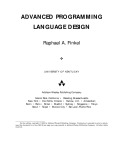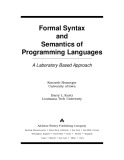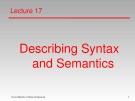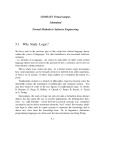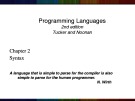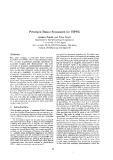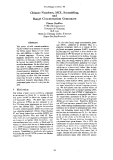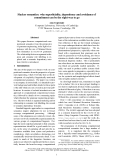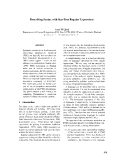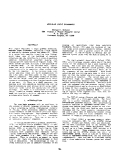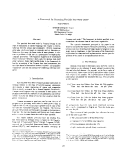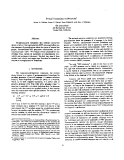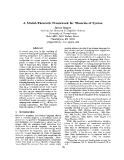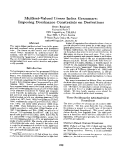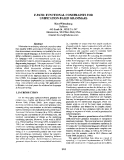
Formal syntax
-
"Ebook Advanced programming language design" includes contents: Chapter 1 introduction, chapter 2 control structures, chapter 3 types, chapter 4 functional programming, chapter 5 object-oriented programming, chapter 6 dataflow, chapter 7 concurrent programming, chapter 8 logic programming, chapter 9 aggregates, chapter 10 formal syntax and semantics.
 370p
370p  longtimenosee08
longtimenosee08
 31-03-2024
31-03-2024
 6
6
 1
1
 Download
Download
-
Ebook "Formal syntax and semantics of programming languages" includes content: Specifying syntax, introduction to laboratory activities, attribute grammars, two level grammars, the lambda calculus, self definition of programming languages, translational semantics, traditional operational semantics,.... and other contents.
 654p
654p  haojiubujain07
haojiubujain07
 20-09-2023
20-09-2023
 4
4
 3
3
 Download
Download
-
Lecture Formal methods in software engineering - Lecture 17 presents the following content: Semantics, operational semantics, evaluation of operational semantics, axiomatic semantics, axiomatic semantics form, axiomatic semantics - consequence, loop invariant, evaluation of axiomatic semantics.
 24p
24p  larachdumlanat126
larachdumlanat126
 31-12-2020
31-12-2020
 16
16
 2
2
 Download
Download
-
Now that we have learned the basics of syntax of predicate logic, we can have a look at the semantics. This is brought about by a relational structure M, which realizes (or instantiates) the symbols of our language. Moreover M tells us which formulas are valid.
 6p
6p  larachdumlanat126
larachdumlanat126
 31-12-2020
31-12-2020
 22
22
 1
1
 Download
Download
-
We have seen in the previous part of this script how formal language theory studies the syntax of languages. Yet, this formalism is not concerned with how sentences – i.e. elements of a language – are related to each other. In other words, formal language theory does not answer the question of how a sentence can be derived from already existing sentences.
 6p
6p  larachdumlanat126
larachdumlanat126
 31-12-2020
31-12-2020
 7
7
 0
0
 Download
Download
-
Chapter 2 - Syntax. We shall see that most of the syntactic structure of modern programming languages is defined using a linguistic formalism called the contextjree grammm: Other elements of syntax are outside the realm of context-free grammars, and are defined by other means. A careful treatment of programming language syntax appears in Chapter 2. This chapter provides knowledge of grammars of syntax: backus-naur form, derivations, parse trees.
 23p
23p  thiendiadaodien_8
thiendiadaodien_8
 24-02-2019
24-02-2019
 24
24
 1
1
 Download
Download
-
The paper presents a constraint based semantic formalism for HPSG. The syntax-semantics interface directly implements syntactic conditions on quantifier scoping and distributivity. 1 The construction of semantic representations is guided" by general principles governing the interaction between syntax and semantics. Each of these principles acts as a constraint to narrow down the set of possible interpretations of a sentence.
 8p
8p  buncha_1
buncha_1
 08-05-2013
08-05-2013
 33
33
 1
1
 Download
Download
-
The notion of mild context-sensitivity was formulated in an attempt to express the formal power which is both necessary and sufficient to define the syntax of natural languages. However, some linguistic phenomena such as Chinese numbers and German word scrambling lie beyond the realm of mildly contextsensitive formalisms. On the other hand, the class of range concatenation grammars provides added power w.r.t, mildly context-sensitive grammars while keeping a polynomial parse time behavior.
 8p
8p  bunthai_1
bunthai_1
 06-05-2013
06-05-2013
 46
46
 2
2
 Download
Download
-
This paper discusses computational compositional semantics from the perspective of grammar engineering, in the light of experience with the use of Minimal Recursion Semantics in DELPH - IN grammars. The relationship between argument indexation and semantic role labelling is explored and a semantic dependency notation (DMRS) is introduced. approach prevents us from over-committing on the basis of the information available from the syntax. One reflection of this are the formal techniques for scope underspecification which have been developed in computational linguistics. ...
 9p
9p  bunthai_1
bunthai_1
 06-05-2013
06-05-2013
 44
44
 2
2
 Download
Download
-
Syntactic constraints in Koskenniemi's Finite-State Intersection Grammar (FSIG) are logically less complex than their formalism (Koskenniemi et al., 1992) would suggest: It turns out that although the constraints in Voutilainen's (1994) FSIG description of English make use of several extensions to regular expressions, the description as a whole reduces to a finite combination of union, complement and concatenation. This is an essential improvement to the descriptive complexity of ENGFSIG.
 8p
8p  bunthai_1
bunthai_1
 06-05-2013
06-05-2013
 42
42
 1
1
 Download
Download
-
This grammar formalism, a high degree of modularity between syntax and semantics. There is a syntax rule compiler (compiling into Prolog) which takes care of the building of analysis structures and the interface to a clearly separated semantic interpretation component dealing with scoping and the construction of logical forms. The whole system can work in either a one-pass mode or a two-pass mode. [n the one-pass mode, logical forms are built directly during parsing through interleaved calls to semantics, added automatically by the rule compiler. ...
 14p
14p  bungio_1
bungio_1
 03-05-2013
03-05-2013
 40
40
 1
1
 Download
Download
-
intermediate depencies between morphology, syntax and semantics. A strong, multidimensional formalism that can cope with d i f f e r e n t l e v e l s of language seems necessary. In t h i s chapter a graph grammar formalism based on the notions of r e l a t i o n a l graph grammars ( R a j l i c h 1975) and a t t r i b u t e d programmed graph grammars (Bunke 1982) is developed f o r parsing languages with configurational structure .
 4p
4p  bungio_1
bungio_1
 03-05-2013
03-05-2013
 27
27
 1
1
 Download
Download
-
The GTI~syst~m is a tree-to-tree transducer developed for teaching purposes in machine translation. The transducer is a specialized production system giving the linguists the tools for expressing infon~ation in a syntax that is close to theoretical linguistics. Major emphasis was placed on developing a system that is user friendly, uniform and legible. This paper describes the linguistic data structure, the rule formalism and the control facilities that the linguist is provided with.
 4p
4p  bungio_1
bungio_1
 03-05-2013
03-05-2013
 38
38
 1
1
 Download
Download
-
German word order) The framework is slightly modified to accommodate the relevant class of word order regularities. The syntactic framework presented in this paper is not hound to any particular theory of discourse processing; it enables syntax to interact with whatever formal model of pragmatics one might want to implement. A brief discussion of the framework's implication~ for computational implementation centers Upon the problem of the status of metagrammatical devices.
 7p
7p  bungio_1
bungio_1
 03-05-2013
03-05-2013
 34
34
 1
1
 Download
Download
-
Metagrammaticai formalisms that combine context-free phrase structure rules and metarules (MPS grammars) allow concise statement of generalizations about the syntax of natural languages. Unconstrained MPS grammars, tmfortunately, are not cornputationally "safe." We evaluate several proposals for constraining them, basing our amae~ment on computational tractability and explanatory adequacy. We show that none of them satisfies both criteria, and suggest new directions for research on alternative metagrammatical formalisms. ...
 6p
6p  bungio_1
bungio_1
 03-05-2013
03-05-2013
 40
40
 4
4
 Download
Download
-
A natural next step in the evolution of constraint-based grammar formalisms from rewriting formalisms is to abstract fully away from the details of the grammar mechanism--to express syntactic theories purely in terms of the properties of the class of structures they license.
 7p
7p  bunmoc_1
bunmoc_1
 20-04-2013
20-04-2013
 66
66
 2
2
 Download
Download
-
This paper defines multiset-valued linear index grammar and unordered vector grammar with dominance links. The former models certain uses of multisetvalued feature structures in unification-based formalisms, while the latter is motivated by word order variation and by "quasi-trees", a generalization of trees. The two formalisms are weakly equivalent, and an important subset is at most context-sensitive and polynomially parsable.
 8p
8p  bunmoc_1
bunmoc_1
 20-04-2013
20-04-2013
 54
54
 2
2
 Download
Download
-
This paper shows how to formally characterize language learning in a finite parameter space as a Markov structure, hnportant new language learning results follow directly: explicitly calculated sample complexity learning times under different input distribution assumptions (including CHILDES database language input) and learning regimes. We also briefly describe a new way to formally model (rapid) diachronic syntax change.
 10p
10p  bunmoc_1
bunmoc_1
 20-04-2013
20-04-2013
 42
42
 3
3
 Download
Download
-
Motivation for including relational constraints other than equality within grammatical formalisms has come from discontinuous constituency and partially free word order for natural languages as well as from the need to define combinatory operations at the most basic level for languages with a two-dimensional syntax (e.g., mathematical notation, chemical equations, and various diagramming languages). This paper presents F-PATR, a generalization of the PATR-II unification-based formalism, which incorporates relational constraints expressed as user-defined functions. ...
 8p
8p  bunmoc_1
bunmoc_1
 20-04-2013
20-04-2013
 46
46
 1
1
 Download
Download
-
A number of grammatical formalisms were introduced to define the syntax of natural languages. Among them are parallel multiple context-free grammars (pmcfg's) and lexical-functional grammars (lfg's). Pmcfg's and their subclass called multiple context-free grammars (mcfg's) are natural extensions of cfg's, and pmcfg's are known to be recognizable in polynomial time. Some subclasses of lfg's have been proposed, but they were shown to generate an AlP-complete language. Finite state translation systems (fts') were introduced as a computational model of transformational grammars. ...
 10p
10p  bunmoc_1
bunmoc_1
 20-04-2013
20-04-2013
 48
48
 1
1
 Download
Download
CHỦ ĐỀ BẠN MUỐN TÌM








